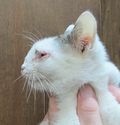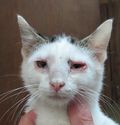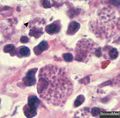 What is wrong with this kitten? How did she get this classic "Roman Nose" profile? She wasn't born with it. She has an infection called Histoplasmosis, a systemic fungus.
What is wrong with this kitten? How did she get this classic "Roman Nose" profile? She wasn't born with it. She has an infection called Histoplasmosis, a systemic fungus.
Most folks have heard of "toe-nail fungus" or "athlete's foot" or ringworm. These are fungus infections of the skin, and they don't go deep into the body. They are very unlikely to affect any internal organs, or make you sick. You just get funky-looking itchy places.
Systemic fungus infections are very dangerous indeed. In our area, the two most common are Histoplasmosis and Blastomycosis. We are in an endemic area for both (meaning that the fungus is widespread and it's been here for a long time, and it's not going away).
 The fungal spores live a very long time in the soil, and it's not really possible to get rid of them. A specialist once told me that you would have to soak your yard six inches deep with formaldehyde. Even supposing you were willing and able to do this, it would kill everything in your yard, plus it would be illegal. The stuff is dangerous. The Department of Natural Resources and the Environmental Protection Agency would be all over you. So, that's not happening.
The fungal spores live a very long time in the soil, and it's not really possible to get rid of them. A specialist once told me that you would have to soak your yard six inches deep with formaldehyde. Even supposing you were willing and able to do this, it would kill everything in your yard, plus it would be illegal. The stuff is dangerous. The Department of Natural Resources and the Environmental Protection Agency would be all over you. So, that's not happening.
Fortunately, the spores rarely grow into the lifestage of the fungus that is infectious. We're not sure what stimulates the Blastomyces fungus. We just know that it thrives in swampy soil. For us, that means anyplace you could drive to in an hour. I've seen cases even from high, well-drained sandy areas in southeast Missouri. Still swampy enough, apparently.
 Histoplasma spores are fertilized by bird manure. Beware of starling roosts, chicken houses, and so forth. If your yard looks like this car, be careful. If you have to clean up such a place, be sure to wear a respirator so you don't inhale any of the dust.
Histoplasma spores are fertilized by bird manure. Beware of starling roosts, chicken houses, and so forth. If your yard looks like this car, be careful. If you have to clean up such a place, be sure to wear a respirator so you don't inhale any of the dust.
I have been told by public health authorities that most people in my area have had enough exposure to this that you can find they have some immunity if you blood-test them. It may not be enough to overcome massive exposure, though. Wear that respirator.
Even though the Histoplasma fungus is extremely common in our soil, I rarely see cases of it — less than half a dozen in over 30 years. Blastomycosis, on the other hand, we see several times each year.
Both germs can affect lungs, lymph nodes, skin, intestinal tract, even the bones and eyeballs. Really, the fungus can go about anywhere inthe body. We suspect a systemic fungus when an infection doesn't respond to antibiotics, as we would expect a bacterial infection to do.
There are certain patterns that develop on the chest X-ray that are more common with a fungus-caused pneumonia than with bacteria or viruses.
 Sometimes you can find the organism in pus if you have an open sore place on the skin. On the left, you see Blastomyces,which looks pretty big next to these white blood cells around it. It's the double-walled, budding yeast.
Sometimes you can find the organism in pus if you have an open sore place on the skin. On the left, you see Blastomyces,which looks pretty big next to these white blood cells around it. It's the double-walled, budding yeast.
On the right, you see Histoplasma organisms, which in this photo are actually within big white blood cells called macrophages that are trying to eat them and kill them.
In this little kitten's case, we were able to find it when we drew some cells out of a swollen lymph node. Our sample looked a lot like the pictue. More frequently, you cannot find the organism, so you want to test for it.
In years past (and sometimes now), we sent out blood samples. Unfortunately, these often give false negative tests in the early course of the disease. Now there is a test for the fungus antigens (microscopic pieces of the fungus itself) that uses urine specimens. Surprisingly, this is more sensitive and more accurate as a general rule. We send them to MiraVista Labs.
 Our patient started out with the swollen nose, and little sore nodules on her eyelids. At first, antibiotics seemed to help, then things got worse, and the lymph nodes began to swell. We suspected systemic fungus and knew we had something suspicious in those cells from the lymph node. Treatment with itraconazole was started right away, and we soon had confirmation of Histoplasmosis from the University of Missouri Clinical Pathology laboratory.
Our patient started out with the swollen nose, and little sore nodules on her eyelids. At first, antibiotics seemed to help, then things got worse, and the lymph nodes began to swell. We suspected systemic fungus and knew we had something suspicious in those cells from the lymph node. Treatment with itraconazole was started right away, and we soon had confirmation of Histoplasmosis from the University of Missouri Clinical Pathology laboratory.
This patient has no history of exposure to the bird manure, and she tested negative for the immunosuppressive diseases we see in cats (Feline Leukemia virus and Feline Immunodeficiency virus). She was very small for her age, however, so her body defenses may not be all they should be. So far, she seems to be responding well to treatment.
Even with the right medicine, it takes two months or more of treatment to eliminate the infection. With a two-pound kitten like this, that's not so bad. With an 80-pound Labrador, it is VERY expensive.
It is also possible to become re-infected down the line, so these are really bad diseases. When they get into the eye, that eye is usually lost. If a testicle is affected, surgical removal is indicated. Bad stuff.
Fortunately, though the micro-organism is very common in our soil, the infections are rare. They are best treated as early as possible when they do occur. If your pet has a persistent infection that doesn't seem to be responding to antibiotics, it's time to consider the possibility of a systemic fungus.


